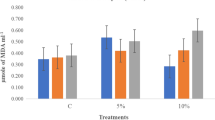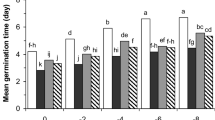Abstract
The present study was aimed to evaluate the effect of different seed priming methods to enhance the sodium chloride (NaCl) and polyethylene glycol-8000 (PEG-8000) stress tolerance in Indian mustard (Brassica juncea L.). Seeds subjected to different priming treatments such as water (hydro-priming), calcium chloride (CaCl2) (chemo-priming), and abscisic acid (ABA) (hormonal-priming) showed increased rate of germination as compared to non-primed seeds. The primed and non-primed seeds were grown for 15 days and then the seedlings were independently subjected to iso-osmotic salt (150 mM NaCl) or PEG-8000 (20%) stress. The different biochemical responses were studied 10 days after treatment. Under NaCl and PEG stress, the dry weight and total chlorophyll content were higher in primed sets as compared to non-primed treatment which was also evident by the phenotype of the seedlings. In general, the higher activities of superoxide dismutase and glutathione reductase resulted in lower oxidative damage, in terms of malondialdehyde content, under NaCl and PEG stress in hydro-primed set as compared to non-primed, ABA-, and CaCl2-primed treatments. Besides, the level of total phenolics and accumulation of osmolytes such as free proline, glycine betaine, and total soluble sugars was also lower in hydro-primed set as compared to other primed and non-primed treatments. The study thus suggests the use of hydro-priming as a simple and cost-effective strategy to alleviate the NaCl and PEG induced stress in B. juncea.






Similar content being viewed by others
Abbreviations
- ABA:
-
Abscisic acid
- ANOVA:
-
Analysis of variance
- CaCl2 :
-
Calcium chloride
- CP:
-
Seedlings derived from the CaCl2-primed seeds
- CRD:
-
Completely randomized design
- DMRT:
-
Duncan’s multiple range test
- EDTA:
-
Ethylenediaminetetraacetic acid
- GR:
-
Glutathione reductase
- HP:
-
Seedlings derived from the ABA-primed seeds
- MDA:
-
Malondialdehyde
- MS:
-
Murashige and Skoog basal medium
- NaCl:
-
Sodium chloride
- NP:
-
Seedlings derived from the non-primed seeds
- PEG:
-
Polyethylene glycol-8000
- SOD:
-
Superoxide dismutase
- TBARS:
-
Thiobarbituric acid reactive substances
- WP:
-
Seedlings derived from the hydro-primed seeds
References
Ahmad MSA, Javed F, Ashraf M (2007) Iso-osmotic effect of NaCl and PEG on growth, cations and free proline accumulation in callus tissue of two indica rice (Oryza sativa L.) genotypes. Plant Growth Reg 53:53–63
Ainsworth EA, Gillespie KM (2007) Estimation of total phenolic content and other oxidation substrates in plant tissues using Folin–Ciocalteu reagent. Nat Prot 2:875–877
Alscher RG (1989) Biosynthesis and antioxidant function of glutathione in plants. Physiol Plant 77:457–464
Arnon DI (1949) Copper enzymes in isolated chloroplasts, polyphenol oxidase in Beta vulgaris L. Plant Physiol 24:1–15
Ashraf MY, Azmi AR, Khan AH, Ala SA (1994) Effect of water stress on total phenols peroxidase activity and chlorophyll content in wheat (Triticum aestivum L.). Acta Physiol Plant 16:185–191
Badawi GH, Yamauchi Y, Shimada E, Sasaki R, Kawano N, Tanaka K, Tanaka K (2004) Enhanced tolerance to salt stress and water deficit by over-expressing superoxide dismutase in tobacco (Nicotiana tabacum) chloroplasts. Plant Sci 166:919–928
Bartels D, Sunkar R (2005) Drought and salt tolerance in plants. Crit Rev Plant Sci 24:23–58
Bates LS, Waldren RP, Teare ID (1973) Rapid determination of proline for water stress studies. Plant Soil 39:205–207
Beauchamp C, Fridovich I (1971) Superoxide dismutase: improved assays and an assay applicable to acrylamide gels. Anal Biochem 44:276–287
Beckers GJM, Conrath U (2007) Priming for stress resistance: from the lab to the field. Curr Opin Plant Biol 10:425–431
Bewley JD (1997) Seed germination and dormancy. Plant Cell 9:1055–1066
Brougham RW (1960) The relationship between the critical leaf area, total chlorophyll content, and maximum growth-rate of some pasture and crop plants. Ann Bot 24:463–474
Bruce TJA, Matthes MC, Napier JA, Pickett JA (2007) Stressful ‘‘memories’’ of plants: evidence and possible mechanisms. Plant Sci 173:603–608
Camara TR, Willadino L, Torne JM, Manick A, Santos MA (2000) Effect of salt stress and exogenous proline in maize callus. Rev Brasil de Fisiol Vegetal 12:146–155
Casenave EC, Toselli ME (2007) Hydropriming as a pre-treatment for cotton germination under thermal and water stress conditions. Seed Sci Tech 35:88–98
Cushman JC (2001) Osmoregulation in plants: implications for agriculture. Amer Zool 41:758–769
Fatima RA, Ahmad M (2004) Certain antioxidant enzymes of Allium cepa as biomarkers for the detection of toxic heavy metals in wastewater. Sci Total Environ 346:256–273
Foti R, Abureni K, Tigere A, Gotos J, Gere J (2008) The efficacy of different seed priming osmotica on the establishment of maize (Zea mays L.) caryopses. J Arid Environ 72:1127–1130
Gangopadhyay G, Basu S (2000) Proline as osmotic stress marker in in vitro system. In: Hemantaranjan A (ed) Plant physiology, biochemistry and plant molecular biology in 2000, vol 3. Scientific Publishers, Jodhpur, India, pp 283–304
Grieve CM, Grattan SR (1983) Rapid assay for determination of water soluble quaternary ammonium compounds. Plant Soil 70:303–307
Gunstone FD (2001) Production and consumption of rapeseed oil on a global scale. Eur J Lipid Sci Tech 103:447–449
Harris D, Raghuwanshi BS, Gangwar JS, Singh SC, Joshi KD, Rashid A, Hollington PA (2001) Participatory evaluation by farmers of ‘on-farm’ seed priming in wheat in India, Nepal, Pakistan. Expt Agric 37:403–415
He DY, Yu SW (1995) In vitro selection of a high-proline producing variant from rice callus and studies on its salt tolerance. Acta Phytophys Sin 21:65–72
Heydecker W, Higgins J, Gulliver RL (1973) Accelerated germination by osmotic seed treatment. Nature 246:42–44
Hichem H, Mounir D, Naceur A (2009) Differential responses of two maize (Zea mays L.) varieties to salt stress: changes on polyphenols composition of foliage and oxidative damages. Ind Crops Prod 30:144–151
Iqbal M, Ashraf M (2007) Seed treatment with auxins modulates growth and ion partitioning in salt-stressed wheat plants. J Int Plant Biol 49:1003–1015
Job D, Capron I, Job C, Dacher F, Corbineau F, Come D (2000) Identification of germination-specific protein markers and their use in seed priming technology. In: Black M, Bradford KJ, Vazquez-Ramos J (eds) Seed biology: advances and applications. CAB International, Wallingford, UK, pp 449–459
Kaiser WM, Schwitulla M, Wirth E (1983) Reactions in chloroplasts, cytoplasm and mitochondria of leaf slices under osmotic stress. Planta 158:302–308
Kamboh MA, Oki Y, Adachi T (2000) Effect of pre-sowing seed treatments on germination and early seedling growth of wheat varieties under saline conditions. Soil Sci Plant Nut 46:249–255
Kaur S, Gupta AK, Kaur N (2002) Effect of osmo- and hydropriming of chickpea seeds on seedling growth and carbohydrate metabolism under water deficit stress. Plant Growth Reg 37:17–22
Kaya MD, Okcu G, Atak M, Cikili Y, Kolsanci O (2006) Seed treatments to overcome salt and drought stress during germination in sunflower (Helianthus annuus L.). Eur J Agron 24:291–295
Khan MA, Ungar IA (1984) Seed polymorphism and germination responses to salinity stress in Atriplex triangularis. Willd Bot Gaz 145:487–494
Lowry OH, Roenbrough NJ, Farr AL, Randal EJ (1951) Protein measurement with the folin phenol reagent. J Biol Chem 193:265–275
McDonald MB (2000) Seed priming. In: Black M, Bewley JD (eds) Seed technology and its biological basis. Sheffield Academic Press, Sheffield, UK, pp 287–325
Melchiorre M, Robert G, Trippi V, Racca R, Lascano HR (2009) Superoxide dismutase and glutathione reductase overexpression in wheat protoplast: photooxidative stress tolerance and changes in cellular redox state. Plant Growth Reg 57:57–68
Mittler R (2002) Oxidative stress, antioxidants and stress tolerance. Trends Plant Sci 7:405–410
Murashige T, Skoog F (1962) A revised medium for rapid growth and bioassays with tobacco cultures. Physiol Plant 15:473–497
Patade VY, Suprasanna P, Bapat VA (2008) Effects of salt stress in relation to osmotic adjustment on sugarcane (Saccharum officinarum L.) callus cultures. Plant Growth Reg 55:169–173
Patade VY, Bhargava S, Suprasanna P (2009) Halopriming imparts tolerance to salt and PEG induced drought stress in sugarcane. Agri Ecosyst Environ 134:24–28
Purty RS, Kumar G, Singla-Pareek SL, Pareek A (2008) Towards salinity tolerance in Brassica: an overview. Physiol Mol Biol Plants 14:39–49
Rehman S, Harris PJC, Bourne WF (1998) Effects of pre-sowing treatments with calcium salts, potassium salts and water on germination and salt tolerance of Acacia seeds. J Plant Nut 21:277–285
Smith IK, Vierheller TL, Thorne CA (1988) Assay of glutathione reductase in crude tissue homogenates using 5, 5′-dithiobis(2-nitrobenzoic acid). Anal Biochem 175:408–413
Srinivasan K, Saxena S, Singh BB (1999) Osmo- and hydropriming of mustard seeds to improve vigour and some biochemical activities. Seed Sci Tech 27:785–793
Srivastava S, Mishra S, Tripathi RD, Dwivedi S, Gupta DK (2006) Copper-induced oxidative stress and responses of antioxidants and phytochelatins in Hydrilla verticillata (L.f.) Royle. Aquat Toxicol 80:405–415
Taylor AG, Harman GE (1990) Concepts and technologies of selected seed treatments. Ann Rev Phytopathol 28:321–329
Watanabe S, Kojima K, Ide Y, Sasaki S (2000) Effects of saline and osmotic stress on proline and sugar accumulation in Populus euphratica in vitro. Plant Cell Tissue Organ Cult 63:199–206
Yagmur M, Kaydan D (2008) Alleviation of osmotic stress of water and salt in germination and seedling growth of triticale with seed priming treatments. Afr J Biotech 7:2156–2162
Zhu JK (2001) Plant salt tolerance. Trends Plant Sci 6:66–71
Acknowledgments
The authors would like to thank Dr. S. J. Jambhulkar, NABTD, for providing seed material of TM2. They are also thankful to Dr. Sudhakar Srivastava, NABTD, for giving critical suggestions during manuscript preparation.
Author information
Authors and Affiliations
Corresponding author
Additional information
Communicated by S. Weidner.
A. K. Srivastava, V. H. Lokhande and V. Y. Patade have contributed equally.
Rights and permissions
About this article
Cite this article
Srivastava, A.K., Lokhande, V.H., Patade, V.Y. et al. Comparative evaluation of hydro-, chemo- , and hormonal-priming methods for imparting salt and PEG stress tolerance in Indian mustard (Brassica juncea L.). Acta Physiol Plant 32, 1135–1144 (2010). https://doi.org/10.1007/s11738-010-0505-y
Received:
Revised:
Accepted:
Published:
Issue Date:
DOI: https://doi.org/10.1007/s11738-010-0505-y




